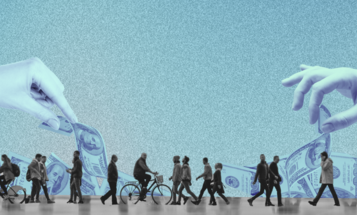
Weak Unions, Weak Economy
Why the Decline of Organized Labor Makes it Harder to Revive Growth
"If we had more freight to haul, we'd be doing more hiring," trucking executive Barbara Windsor explained to President Obama earlier this year. From the small businesses suffering weak sales and a shortfall of customers to the large companies now stockpiling tens of billions in cash the fundamental problem with our economy is the same: a lack of consumer demand means substantial investment and hiring in the U.S. are often irrational from a business perspective. The nation’s sky-high unemployment and underemployment rates are the biggest immediate cause of the anemic demand. But a closer look at the long-term trends underlying consumer spending power suggests another, less recognized culprit lurking in the weeds: union busting.
To understand how a decades-long legacy of union busting is making our recovery harder, consider the role that organized labor has traditionally played in ensuring that working people – who make up most consumers -- receive a larger share of the economy’s gains and thus have money to spend consuming. Unions bargain collectively for better wages and benefits for their members. But unions also raise compensation for workers they don’t represent: a recent study by professors Bruce Western and Jake Rosenfeld finds that by scaring non-union employers into raising wages to avoid unionization, promoting norms of fair pay, and lobbying for public policies that raise wages, unions substantially boost compensation for non-union employees in addition to their own members. In short, high unionization boosts the share of economic growth going to working people rather than to corporate profits or the very highest earners. That is good for consumer spending given that Americans of moderate means are more likely to spend additional money than the wealthy, who already are consuming at their desired level, or corporations, which may just pile up more cash.
 Unfortunately, though, unionization rates have been in decline for decades and the share of national income going to the middle class has fallen too. Meanwhile, the proportion of pay held by the highest-income Americans has shot up dramatically: in 2007, the top ten percent of households earned 49.7 percent of the nation’s income. Factors like globalization, technological change, and especially the demand for highly skilled workers that has put a premium on the value of a college education contribute to the divergence between the middle class and the wealthy, but Western and Rosenfeld make a powerful case that the decline of union representation was also a major influence – contributing as much as third to the growth of income inequality among working men since 1973. Without unions or any other organized force to fight for workers’ share of economic gains, the middle class is dwindling – and so is its purchasing power. This trend was obscured during the early 2000s as Americans tapped credit cards and rising home equity to support their consumer spending.
Unfortunately, though, unionization rates have been in decline for decades and the share of national income going to the middle class has fallen too. Meanwhile, the proportion of pay held by the highest-income Americans has shot up dramatically: in 2007, the top ten percent of households earned 49.7 percent of the nation’s income. Factors like globalization, technological change, and especially the demand for highly skilled workers that has put a premium on the value of a college education contribute to the divergence between the middle class and the wealthy, but Western and Rosenfeld make a powerful case that the decline of union representation was also a major influence – contributing as much as third to the growth of income inequality among working men since 1973. Without unions or any other organized force to fight for workers’ share of economic gains, the middle class is dwindling – and so is its purchasing power. This trend was obscured during the early 2000s as Americans tapped credit cards and rising home equity to support their consumer spending.
The disempowerment of working people is so complete that American workers have received just over one percent of income growth since the recession technically ended in the second quarter of 2009. Meanwhile 88 percent of real national income went to corporate profits. “The absence of any positive share of national income growth due to wages and salaries received by American workers during the current economic recovery is historically unprecedented” pronounced economists at Northeastern University who analyzed the numbers. No wonder corporations are sitting on tremendous cash reserves and working people can’t generate enough demand to give businesses a reason to hire.
Polls show that far more American workers would like to be part of a union than is now the case. The decline of organized labor can be attributed to a number of factors, including the decline of traditionally unionized industries in manufacturing and the unwillingness of some union leadership to invest in new organizing. But another major factor is also at work: a decades-long effort by big business lobbyists to water down the nation’s labor regulations so that corporations can, with near impunity, obstruct their employees’ efforts to choose a union.
An analysis of union elections from 1999 to 2003 revealed that when workers attempted to organize a union, 96 percent of employers mounted a campaign against their effort. Three quarters of employers hired outside consultants. So while many workers wish to join unions, they often change their minds after an intimidating one-on-one anti-union meeting with their direct supervisor once a week or more leading up to a union election (a tactic employers used in 66 percent of organizing campaigns), after their boss threatens to close down the workplace if workers decide to unionize (57 percent of organizing campaigns), or after those co-workers who most openly support the union are fired (34 percent of organizing campaigns).
The wide prevalence of modern day union-busting helps explain stagnant household incomes for the middle class amid record corporate profits. Long term, though, it is hard to see business can thrive in an economy where workers have limited spending power as the lion’s share of income gains goes to top earners. Moreover, simply adding new jobs won’t reverse this situation if those jobs pay low wages, which is now the case.
In the Great Recession, the economy lost the most middle-class jobs, but the new jobs created since are disproportionally low-wage positions. To the extent we are seeing new job growth, it is disproportionately for positions like retail sales, cashiers, and food preparation workers, jobs with a median wage between $9 and $11 an hour and often no benefits.
In the heyday of union organizing, collective bargaining transformed poorly paid jobs like these into decent positions that enabled working people to support their families and earn a middle-class standard of living, supporting consumption that, in turn, sustained the economy. This can happen again if elected leaders take action to reinforce the nation’s weakened labor laws, making it easier for workers to join unions and expand their slice of the economic pie. The most important step Congress could take is to pass the Employee Free Choice Act (EFCA), which would streamline the process of forming unions in the workplace and prohibit some current forms of union-busting by employers.
Two Years ago, the EFCA was buried in the Senate by the threat of filibuster and its prospects in Congress remain bleak. But, with consumer spending remaining flat and GDP growth anemic, it is time that Congress recognized the stronger unions are one obvious way to put more into the pockets of Americans workers and get this economy moving again.



